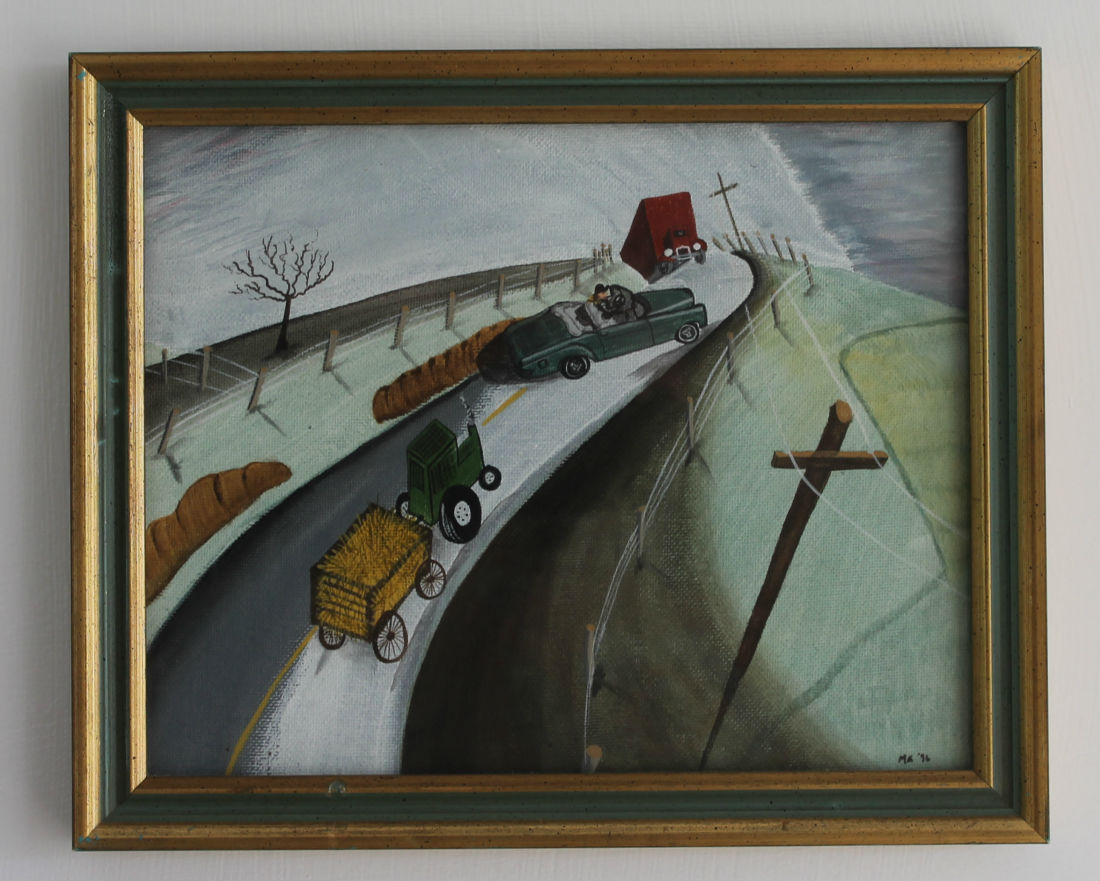Dr. Eleanor McQuillen’s Crime Scene Painting Haste Makes Waste
“MVA while passing farm vehicle” is the only note my mom provided with this painting. As the fourth painting in her series, this painting shares another crime scene she was regularly called on to investigate, a motor vehicle accident. Like the third painting, this is more symbolic than literal. Unlike the other paintings this focuses on the moment before the accident, rather than the aftermath. These decisions were probably heavily influenced by her visual inspiration.
When I first saw the undulating and geometric landscape, coupled with the elevated bird’s-eye view, I thought of Grant Wood’s work. I didn’t realize how much my mother appropriated his composition and style until I found his Death on the Ridge Road. Wood typically romanticized country living and excluded modern machines from his paintings. This is one of the few paintings that depict automobiles, and the two ominous black cars racing toward the hard-edged red truck reflected Wood’s feelings for the mechanized and industrial. My mom’s revisions altered this interpretation. Her lone individual in a fancy convertible passing a working tractor speaks more about speed and bad judgment; two common ingredients in MVAs.
This painting also reminds me of one of her go-to parenting techniques. My parents regularly recounted graphic details from accident scenes to teach us kids life lessons. Don’t speed and don’t play with matches were more memorable admonishments when supported by visual aids. While she never showed me a picture of someone who died by gulping air as a way to burp the alphabet, apparently that killed a boy very much like me.
Next week’s crime scene painting sees the demise of another “flatlander” in A Bad Day for a Goodfella?
Adopt a detective’s perspective when looking at this painting and use three simple questions to frame a class discussion.
- What is going on in this picture?
- What do you see that makes you say that?
- What more can we find?
Decide if and when to share the title of the painting as it may guide, or overly influence, the way students view the work. You will also need to decide if it is beneficial to share the back story that this is a crime scene painting and is painted by one of the crime scene investigators for her child as a way to share life’s thoughts and lessons.
In drawing so heavily from Grant Wood’s Death on the Ridge Road, this painting offers an opportunity to discuss appropriation as an artistic strategy. What is the shared message behind these images? How are they different?


I’m wondering if the two telephone poles, as crosses, symbolize that both the car driver and the truck driver were killed.
These paintings are giving me a whole new appreciation for the style.
The viewer’s interpretation is an important component of any work of art. The telephone poles support the cross imagery. That perspective made me think of Dali’s Christ of St. John of the Cross. http://en.wikipedia.org/wiki/Christ_of_Saint_John_of_the_Cross
Wait, what?! Burping the alphabet can kill you? Nobody told me. How am I still alive?
Oh, and this painting is amazing.